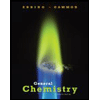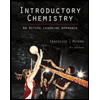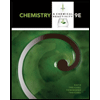
CHEMISTRY THE CENTRAL SCIENCE >EBOOK<
14th Edition
ISBN: 9780136873891
Author: Brown
Publisher: PEARSON
expand_more
expand_more
format_list_bulleted
Concept explainers
Textbook Question
Chapter 1, Problem 83AE
A thief plans to steal a gold sphere with a radius of 28.9 cm from a museum. It the gold has a density of 19.3g/cm3, what is the mass of the sphere in pounds? [The volume of a sphere is V = (4/3 πr)3 Is the thief likely to be able to walk off with the gold sphere unassisted?
Expert Solution & Answer
Want to see the full answer?
Check out a sample textbook solution
Students have asked these similar questions
The two equations are forms of the Davies equation, used in thermodynamics for
activity coefficients:
ال
log Y₁ = -Az²
- 0,31
log
= Az²
- 0,31
1 + √Ĩ
1 + √√
k
These equations are consistent and imply that
Yi
=
Is this last equation correct?
k
For the Davies equation, both expressions are correct:
log Y₁ = -Az²
√i
- 0,31
1 +
√
k
log-
= Az
- 0,31
k
1 + √Ĩ
k
In Davies' equation log y₁ = log-
log y₁ = log | = -Az² + ✓//
k
A is a constant that always equals 1.02. Correct?
- 0,31
Chapter 1 Solutions
CHEMISTRY THE CENTRAL SCIENCE >EBOOK<
Ch. 1.2 - Practice Exercise 1 Which of the following is the...Ch. 1.2 - Aspirin is composed of 60.0% carbon, 4.5%...Ch. 1.5 - Practice Exercise 1 Which of the following weights...Ch. 1.5 - Practice Exercise 2 How many picometers are there...Ch. 1.5 - Practice Exercise 1 Using Wolfram Alpha...Ch. 1.5 - Practice Exercise 2 Ethylene glycol, the major...Ch. 1.5 - Practice Exercise 1 Platinum, Pt. is one of the...Ch. 1.5 - Practice Exercise 2 Calculate the density of a...Ch. 1.5 - Which of the following objects has the greatest...Ch. 1.5 - Prob. 1.5.2PE
Ch. 1.6 - Which of the following numbers in your personal...Ch. 1.6 - Practice Exercise 2 The back inside cover of the...Ch. 1.6 - Practice Exercise 1 An object is determined to...Ch. 1.6 - Practice Exercise 2 How many significant figures...Ch. 1.6 - Ellen recently purchased a new hybrid car and...Ch. 1.6 - Practice Exercise 2 It takes 10.5 s for a sprinter...Ch. 1.6 - Practice Exercise 1 You are asked to determine the...Ch. 1.6 - Practice Exercise 1 At a particular instant in...Ch. 1.7 - Practice Exercise 2 By using a conversion factor...Ch. 1.7 - Practice Exercise 1 Fabiola, who lives in Mexico...Ch. 1.7 - Practice Exercise 2 A car travels 28 mi per gallon...Ch. 1.7 - Practice Exercise 2 A car travels 28 mi per gallon...Ch. 1.7 - Practice Exercise 2 The surface area of Earth is...Ch. 1.7 - Practice Exercise 1 Composite decking is a...Ch. 1.7 - Practice Exercise 2 The density of the organic...Ch. 1.7 - Practice Exercise 2 If the mass of the container...Ch. 1 - Prob. 1ECh. 1 - Prob. 2ECh. 1 - Musical instruments like trumpets and trombones...Ch. 1 - Consider the two spheres shown here, one made of...Ch. 1 - Is the separation method used in brewing a cup of...Ch. 1 - Identify each of the following as measurements of...Ch. 1 - Three spheres of equal size are composed of...Ch. 1 - The three targets from a rifle range shown below...Ch. 1 - What is the length of the pencil in the following...Ch. 1 - How many significant figures should be reported...Ch. 1 - Consider the jar of jelly beans in the photo. To...Ch. 1 - The photo below shows a picture of an agate stone....Ch. 1 - Classify each of the following as a pure substance...Ch. 1 - Classify each of the following as a pure substance...Ch. 1 - 1.15 Give the chemical symbol or name for the...Ch. 1 - 1.16 Give the chemical symbol or name for each of...Ch. 1 - A solid white substance A is heated strongly in...Ch. 1 - 1.18 You are hiking in the mountains and find a...Ch. 1 - 1.19 In the process of attempting to characterize...Ch. 1 - 1.20
Read the following description of the element...Ch. 1 - Prob. 21ECh. 1 - A match is lit and held under a cold piece of...Ch. 1 - Which separation method is better suited for...Ch. 1 - Two beakers contain clear, colorless liquids. When...Ch. 1 - Prob. 25ECh. 1 - Prob. 26ECh. 1 - Prob. 27ECh. 1 - Prob. 28ECh. 1 - Prob. 29ECh. 1 - Prob. 30ECh. 1 - 121 What exponential notation do the following...Ch. 1 -
1.32 Use appropriate metric prefixes to write the...Ch. 1 - Make the following conversions. 72 °F to °C, 216.7...Ch. 1 - a. The temperature on a warm summer day is 87 °F....Ch. 1 - Prob. 35ECh. 1 - A cube of osmium metal 1.500 cm on a side has a...Ch. 1 - To identify a liquid substance, a student...Ch. 1 - a. After the label fell off a bottle containing a...Ch. 1 - Prob. 39ECh. 1 -
1.40 Silicon for computer chips is grown in large...Ch. 1 - Prob. 41ECh. 1 - 1.42 A watt is a measure of power (the rate of...Ch. 1 - Indicate which of the following are exact numbers;...Ch. 1 - Indicate which of the following are exact numbers:...Ch. 1 - 1.45 What is the number of significant figures in...Ch. 1 - Indicate the number of significant figures in each...Ch. 1 - 1.47 Round each of the following numbers to four...Ch. 1 - 1.48
The diameter of Earth at the equator is 7926...Ch. 1 - Carry out the following operations and express the...Ch. 1 - Carry out the following operations and express the...Ch. 1 - You weigh an object on a balance and read the mass...Ch. 1 - You have a graduated cylinder that contains a...Ch. 1 - 153 Using your knowledge of metric units, English...Ch. 1 - 1.54 Using your knowledge of metric units, English...Ch. 1 - A bumblebee flies with a ground speed of 15.2 m/s....Ch. 1 - 1 56
a The speed of light in a vacuum is 2.998 x...Ch. 1 - Perform the following conversions: 5.00 days to s,...Ch. 1 - Carry out the following conversions: 0.105 in. to...Ch. 1 - How many liters of wine can be held in a wine...Ch. 1 - If an electric car is capable of going 225 km on a...Ch. 1 - The density of air at ordinary atmospheric...Ch. 1 - 1.62 The concentration of carbon monoxide in an...Ch. 1 - Prob. 63ECh. 1 - 1.64 A copper refinery produces a copper ingot...Ch. 1 - 165 Classify ea. al the folbwing as a pure...Ch. 1 - 1.66
Which is more likely to eventually be shown...Ch. 1 -
1.67 A sample of ascorbic acid (vitamin C) is...Ch. 1 - Prob. 68AECh. 1 - SO Two students deterrmne the percen.ge of lead in...Ch. 1 - 1.70
Is Om use of significant figures in ea. of...Ch. 1 - What type of quantity (for example, length,...Ch. 1 - 1.72 Give the derived SI units for each of the...Ch. 1 - 1.73 The distance from Earth to the Moon is...Ch. 1 - 1.74 Which of the following would you characterize...Ch. 1 -
1.75 The U.S. quarter has a mass of 5.67 g and is...Ch. 1 -
1.76 In the United States, water used for...Ch. 1 -
1.77 By using estimation techniques, determine...Ch. 1 - Suppose you decide to define your own temperature...Ch. 1 -
1.79 The liquid substances mercury (density =...Ch. 1 -
1.80 Two spheres of equal volume are placed on...Ch. 1 - Water has a density of 0.997 g/cm3 at 25C ; ice...Ch. 1 - A 32.65-g sample of a solid is placed in a flask....Ch. 1 - A thief plans to steal a gold sphere with a radius...Ch. 1 - Automobile batteries contain sulfuric acid, which...Ch. 1 - A 40-lb container of peat moss measures 14 x 20 x...Ch. 1 - A package of aluminum foil contains 50 ft2of foil,...Ch. 1 - Prob. 87AECh. 1 -
1.88 In 2005, J. Robin Warren and Barry J....Ch. 1 -
1 89 A 25 0-cm.long cylindrical glass tube,...Ch. 1 -
1.90 Gold is alloyed (mixed) with other metals to...Ch. 1 -
1.91 Paper chromatography is a simple but...Ch. 1 -
1.92 Judge the following statements as true or...Ch. 1 -
1.93 You are assigned the task of separating a...Ch. 1 - Prob. 94AE
Knowledge Booster
Learn more about
Need a deep-dive on the concept behind this application? Look no further. Learn more about this topic, chemistry and related others by exploring similar questions and additional content below.Similar questions
- Indicate whether the equality is true Yi How is it obtained? k%arrow_forwardIndicate the relationship between the activity coefficient YA and the rate constant of a bimolecular reaction in solution k and the rate constant at infinite dilution ko.arrow_forwardDescribe the saline effect that occurs in solutions.arrow_forward
- Briefly explain what the infinite dilution rate constant (k∞) consists of.arrow_forwardThe Davies equation corrects the Debye-Hückel limiting law for calculating the activity coefficient of an electrolyte in solution at relatively high concentrations. Mathematically, it is expressed as: log y₁ = -Az²? 1 + √Ĩ - 0,31) Is the formula correct?arrow_forwardDifferentiate between the concepts of "ionic salt effect" and "kinetic salt effect."arrow_forward
- Differentiate the concepts of “salino effect” and “salino kinetic effect”.arrow_forwardCome and compare the Bronsted-Bjerrum calculation, the Debye and Hückel calculation, and the Davies calculation.arrow_forwardplz watch the youtube video (the title of this topic) by roxi H. she explains it step by step but i get the wrong answerarrow_forward
- Writing the rate law implied by a simple mechanism To exit full screen, press and hold esc Suppose the decomposition of ozone proceeds by the following mechanism: step elementary reaction rate constant 1 →>> O3(9) O2(g) + O(g) k₁ 2 03(g) + O(g) → 202(g) k2 Suppose also k₁ »k2. That is, the first step is much faster than the second. Write the balanced chemical equation for the overall chemical reaction: Write the experimentally- observable rate law for the overall chemical reaction. ☐ rate = ☐ Note: your answer should not contain the concentrations of any intermediates. Express the rate constant k for the overall chemical reaction in terms of K1, K2, and (if necessary) the rate constants k-1 and K-2 for the reverse of the two elementary reactions in the mechanism. k = ☐ 000 18 ローロ Ar OOarrow_forwardDeducing a rate law from the change in concentration over time To exit full screen, press and hold esc A chemistry graduate student is studying the rate of this reaction: H2CO3(aq) → H₂O(aq) +CO₂ (aq) - She fills a reaction vessel with H2CO3 and measures its concentration as the reaction proceeds: time (milliseconds) [H2CO3] 0 0.0500 M 10. 0.0266M 20. 0.0181 M 30. 0.0138M 40. 0.0111 M Use this data to answer the following questions. Write the rate law for this reaction. Calculate the value of the rate constant k. Round your answer to 2 significant digits. Also be sure your answer has the correct unit symbol. rate ☐ x10 k = Х 000 18 Ararrow_forwardWriting the rate law implied by a simple mechanism Suppose the formation of tert-butanol proceeds by the following mechanism: step elementary reaction 1 (CH3)3 CBr(aq) → (CH3)2 C* (aq) + Br (aq) 2 (CH3)2C (aq) + OH¯ (aq) → (CH3)2COH(aq) rate constant k₁ k₂ Suppose also k₁ »k2. That is, the first step is much faster than the second. Write the balanced chemical equation for the overall chemical reaction: Write the experimentally- observable rate law for the overall chemical reaction. Note: your answer should not contain the concentrations of any intermediates. rate = k ☐ Express the rate constant k for the overall chemical reaction in terms of K1, K2, and (if necessary) the rate constants k-1 and K-2 for the reverse of the two elementary reactions in the mechanism. k = ☐ □ ☑ G ? 00. 18 Ar Barrow_forward
arrow_back_ios
SEE MORE QUESTIONS
arrow_forward_ios
Recommended textbooks for you
 General Chemistry - Standalone book (MindTap Cour...ChemistryISBN:9781305580343Author:Steven D. Gammon, Ebbing, Darrell Ebbing, Steven D., Darrell; Gammon, Darrell Ebbing; Steven D. Gammon, Darrell D.; Gammon, Ebbing; Steven D. Gammon; DarrellPublisher:Cengage Learning
General Chemistry - Standalone book (MindTap Cour...ChemistryISBN:9781305580343Author:Steven D. Gammon, Ebbing, Darrell Ebbing, Steven D., Darrell; Gammon, Darrell Ebbing; Steven D. Gammon, Darrell D.; Gammon, Ebbing; Steven D. Gammon; DarrellPublisher:Cengage Learning Chemistry & Chemical ReactivityChemistryISBN:9781337399074Author:John C. Kotz, Paul M. Treichel, John Townsend, David TreichelPublisher:Cengage Learning
Chemistry & Chemical ReactivityChemistryISBN:9781337399074Author:John C. Kotz, Paul M. Treichel, John Townsend, David TreichelPublisher:Cengage Learning Chemistry: The Molecular ScienceChemistryISBN:9781285199047Author:John W. Moore, Conrad L. StanitskiPublisher:Cengage Learning
Chemistry: The Molecular ScienceChemistryISBN:9781285199047Author:John W. Moore, Conrad L. StanitskiPublisher:Cengage Learning Introductory Chemistry: An Active Learning Approa...ChemistryISBN:9781305079250Author:Mark S. Cracolice, Ed PetersPublisher:Cengage Learning
Introductory Chemistry: An Active Learning Approa...ChemistryISBN:9781305079250Author:Mark S. Cracolice, Ed PetersPublisher:Cengage Learning Chemistry & Chemical ReactivityChemistryISBN:9781133949640Author:John C. Kotz, Paul M. Treichel, John Townsend, David TreichelPublisher:Cengage Learning
Chemistry & Chemical ReactivityChemistryISBN:9781133949640Author:John C. Kotz, Paul M. Treichel, John Townsend, David TreichelPublisher:Cengage Learning Chemistry: Principles and PracticeChemistryISBN:9780534420123Author:Daniel L. Reger, Scott R. Goode, David W. Ball, Edward MercerPublisher:Cengage Learning
Chemistry: Principles and PracticeChemistryISBN:9780534420123Author:Daniel L. Reger, Scott R. Goode, David W. Ball, Edward MercerPublisher:Cengage Learning

General Chemistry - Standalone book (MindTap Cour...
Chemistry
ISBN:9781305580343
Author:Steven D. Gammon, Ebbing, Darrell Ebbing, Steven D., Darrell; Gammon, Darrell Ebbing; Steven D. Gammon, Darrell D.; Gammon, Ebbing; Steven D. Gammon; Darrell
Publisher:Cengage Learning

Chemistry & Chemical Reactivity
Chemistry
ISBN:9781337399074
Author:John C. Kotz, Paul M. Treichel, John Townsend, David Treichel
Publisher:Cengage Learning

Chemistry: The Molecular Science
Chemistry
ISBN:9781285199047
Author:John W. Moore, Conrad L. Stanitski
Publisher:Cengage Learning

Introductory Chemistry: An Active Learning Approa...
Chemistry
ISBN:9781305079250
Author:Mark S. Cracolice, Ed Peters
Publisher:Cengage Learning

Chemistry & Chemical Reactivity
Chemistry
ISBN:9781133949640
Author:John C. Kotz, Paul M. Treichel, John Townsend, David Treichel
Publisher:Cengage Learning

Chemistry: Principles and Practice
Chemistry
ISBN:9780534420123
Author:Daniel L. Reger, Scott R. Goode, David W. Ball, Edward Mercer
Publisher:Cengage Learning
Measurement and Significant Figures; Author: Professor Dave Explains;https://www.youtube.com/watch?v=Gn97hpEkTiM;License: Standard YouTube License, CC-BY
Trigonometry: Radians & Degrees (Section 3.2); Author: Math TV with Professor V;https://www.youtube.com/watch?v=U5a9e1J_V1Y;License: Standard YouTube License, CC-BY